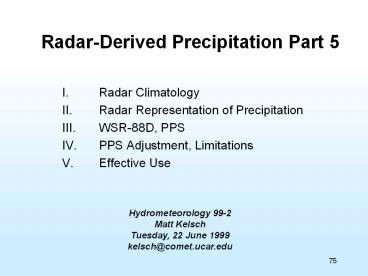Radar-Derived Precipitation Part 5 PowerPoint PPT Presentation
1 / 17
Title: Radar-Derived Precipitation Part 5
1
Radar-Derived Precipitation Part 5
- I. Radar Climatology
- II. Radar Representation of Precipitation
- III. WSR-88D, PPS
- IV. PPS Adjustment, Limitations
- V. Effective Use
Hydrometeorology 99-2 Matt Kelsch Tuesday, 22
June 1999 kelsch_at_comet.ucar.edu
2
V. Effective UseStage I PPS Strengths
- Numerous quality control steps to minimize
limitations both in the radar estimate of
precipitation, and the rain gauge representation
of precipitation. - Spatial and temporal resolution are excellent for
the mesoscale detail of precipitation systems. - Spatial detail over a large area
- Monitor evolution of events between gauge sites
- Real time information
3
(No Transcript)
4
(No Transcript)
5
(No Transcript)
6
(No Transcript)
7
(No Transcript)
8
Stage 1 PPS Strengths (cont.)
- Opportunity for important rainfall information in
remote, poorly instrumented areas. - Adaptation parameters provide some flexibility
for different locations and climate regimes. - Has the versatility to evolve into a better
algorithm that can effectively account for
variability on a geographic, seasonal, and even
hourly basis. - Offers important input for a comprehensive,
multi-sensor system.
9
Radar-Derived PrecipWhen changing Z-R
coefficients is not the real solution
- Range degradation, overshooting low-levels
- Problem associated with propagation of beam, not
Z-R. - Snowfall
- More complexity than liquid hydrometeors.
- Phase changes and mixed phases exist over small
space/time scales. - Range degradation often co-exists.
- Phase change hail, melting snow
- Radical storm-scale changes in Z to R
relationship. - Minimal proof that hail correction can be done
with Z-R. - Inconsistent relationship between Z-R and hail
occurrence.
10
Radar-Derived PrecipWhen changing Z-R may help
- Consistently different average DSD (climate)
- Tropical versus mid-latitude (warm vs. cold
process) - Maritime versus continental
- Consistently different average DSD (season)
- Convective versus stratiform
- Precip System character
- Identify Convective versus Stratiform signature
- Identify warm versus cold rain signature
- Identify maritime versus continental
11
Why cant the adaptation parameters and bias
adjustment procedure solve all the limitations?
- Radar bias adjustment is only one uniform
adjustment. It depends on adequate
representation of precip by the local gauge
network. - Adaptation parameters can greatly help the
algorithm performance for a given site and/or
season. The parameters tune the algorithm for
the typical scenario. Atypical events, such as
unusually high rainfall rates, may not be
diagnosed well. - The most effective use of PPS is to make it a
function of meteorology, not the normal
climatology.
12
Can we account for the important atypical events
without degrading the guidance for the more
common typical events?
- Meteorological information from soundings,
profilers, and surface reports are a few examples
of data sources that can assist with real-time
adjustment of adaptation parameters. - Information from other NEXRAD algorithms, such as
HAIL or VIL, may provide some guidance. - The most effective use of PPS is to make it a
function of meteorology, not the normal
climatology.
13
DATA Soundings and Rainfall RatesWhat are
reasonable maximum rainfall rates expected?
14
(No Transcript)
15
(No Transcript)
16
(No Transcript)
17
Radar-derived PrecipitationA Summary Of Major
Points
- Radar provides one of several useful methods for
sampling precipitation - Quantitative reliability issues are related to
the fact that radar is sampling some volume at
some elevation to estimate precipitation at the
ground - Radar-derived precipitation is most reliably
modeled for liquid hydrometeors hail and snow
add complexity - The above two points are not effectively
corrected by changing Z-R coefficients Z-R
changes should be related to Drop Size
Distribution knowledge. - Radars and rain gauges do not measure equal
samples - Rain gauges do not provide a good representation
of precipitation distribution, especially
convective precip. - Radar provides excellent information about the
spatial and temporal evolution of precipitation
systems.

